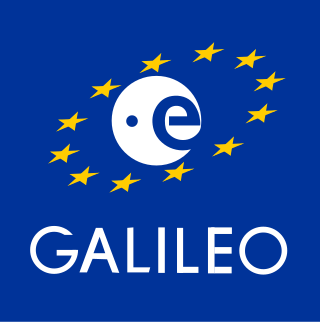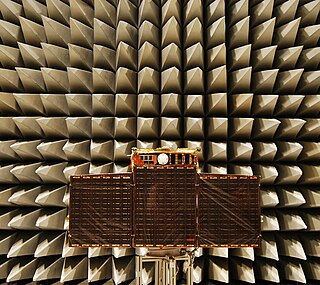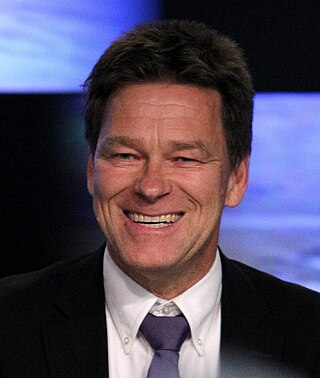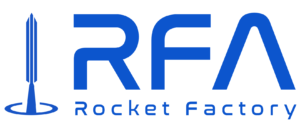
Galileo is a global navigation satellite system (GNSS) that went live in 2016, created by the European Union through the European Space Agency (ESA), operated by the European Union Agency for the Space Programme (EUSPA), headquartered in Prague, Czechia, with two ground operations centres in Fucino, Italy, and Oberpfaffenhofen, Germany. The €10 billion project is named after the Italian astronomer Galileo Galilei.
Matra Marconi Space (MMS) was a Franco-British aerospace company.
Ball Aerospace & Technologies Corp., commonly Ball Aerospace, was an American manufacturer of spacecraft, components and instruments for national defense, civil space and commercial space applications.

The German Aerospace Center is the national center for aerospace, energy and transportation research of Germany, founded in 1969. It is headquartered in Cologne with 35 locations throughout Germany. The DLR is engaged in a wide range of research and development projects in national and international partnerships.

A mission control center is a facility that manages space flights, usually from the point of launch until landing or the end of the mission. It is part of the ground segment of spacecraft operations. A staff of flight controllers and other support personnel monitor all aspects of the mission using telemetry, and send commands to the vehicle using ground stations. Personnel supporting the mission from an MCC can include representatives of the attitude control system, power, propulsion, thermal, attitude dynamics, orbital operations and other subsystem disciplines. The training for these missions usually falls under the responsibility of the flight controllers, typically including extensive rehearsals in the MCC.

The Giant Magellan Telescope is a 25.4-meter, ground-based, extremely large telescope under construction at Las Campanas Observatory in Chile's Atacama Desert. Commissioning is anticipated in the early 2030s. Once complete, the Giant Magellan will be the largest Gregorian telescope ever built observing in optical and mid-infrared light. The telescope uses seven of the world’s largest mirrors to form a light collecting area of 368 square meters.
Surrey Satellite Technology Ltd, or SSTL, is a company involved in the manufacture and operation of small satellites. A spin-off company of the University of Surrey, it is presently wholly owned by Airbus Defence and Space.

SAR-Lupe is Germany's first reconnaissance satellite system and is used for military purposes. SAR is an abbreviation for synthetic-aperture radar, and "Lupe" is German for magnifying glass. The SAR-Lupe program consists of five identical (770 kg) satellites, developed by the German aeronautics company OHB-System, which are controlled by a ground station responsible for controlling the system and analysing the retrieved data. A large data archive of images will be kept in a former Cold War bunker belonging to the Kommando Strategische Aufklärung of the Bundeswehr. The total price of the satellites was over 250 million Euro.
Astrium was an aerospace manufacturer subsidiary of the European Aeronautic Defence and Space Company (EADS) that provided civil and military space systems and services from 2006 to 2013. In 2012, Astrium had a turnover of €5.8 billion and 18,000 employees in France, Germany, the United Kingdom, Spain and the Netherlands. Astrium was a member of Institute of Space, its Applications and Technologies.

Thales Alenia Space is a joint venture between the French technology corporation Thales Group (67%) and Italian defense conglomerate Leonardo (33%). The company is headquartered in Cannes, France.

GMV, founded in 1984, is a Spanish private capital business group with an international presence and more than 3000 workers. In its early days, it focused on the space and defense sectors, being the contract for the European Space Operations Centre (ESOC) the beginning of its growth. Over the years it has diversified its operations and expanded into other fields becoming today's technology group, which comprises 11 areas of specialization: Space, Aeronautics, Defense and Security, Intelligent Transportation Systems (ITS), Automotive, Cybersecurity, Healthcare, and Digital Public Services, Industry, Financial sector, and Services.
Kayser-Threde GmbH based in Munich, Germany is a systems house specializing in applications in manned and unmanned space missions, optics, telematics, crash test data acquisition, and process control for the rail sector. On September 1, 2014, Bremen-based OHB System AG and Munich-based Kayser-Threde GmbH merged under the name OHB System AG, combining both companies' capabilities and capacities.

TET-1 was a microsatellite operated by the German Space Operations Center of the German Aerospace Center. It was the centre of the OOV Program, initiated to offer on-orbit verification possibilities to the German industrial and scientific aerospace community. TET was based on the satellite bus used for the BIRD satellite, which was launched in 2001.
Telespazio UK Ltd. is a British space company based in Luton, Bedfordshire. Founded in 1978 by a small group of engineers at the European Space Operations Centre (ESOC) in Darmstadt, Germany, VEGA presently works with various space agencies, satellite operators and manufacturers around the world. It works with the European Space Agency (ESA) and ESOC in Germany, European Space Research and Technology Centre (ESTEC) in Noordwijk, the Netherlands, ESA Centre for Earth Observation (ESRIN) in Rome, Italy, and European Space Astronomy Centre (ESAC) in Madrid, Spain.
LuxSpace is a European space systems contractor based in Betzdorf in Luxembourg. It was founded in November 2004 as a daughter company of OHB AG, and began operations in January 2005.
Manfred Fuchs was an Italian-German entrepreneur who was the founder of the German space company OHB.
Telespazio Germany GmbH is a European aerospace company, founded in 1978. The company provides consulting, technology and engineering services in aerospace missions for ESOC, EUMETSAT and the German Aerospace Center (DLR).

Hans-Jörg Königsmann is a German aerospace engineer who was Vice President of Flight Reliability for SpaceX until his retirement in 2021.

Rocket Factory Augsburg AG (RFA) is a German New Space start-up located in Augsburg. It was founded in 2018 with the mission to build rockets just like cars. Its multistage rocket, RFA One, is currently under development and scheduled to launch in the summer of 2024.












